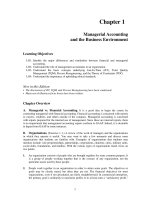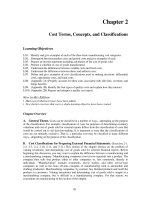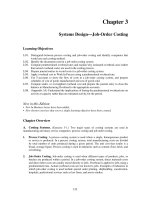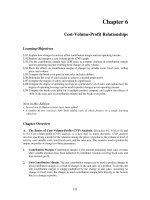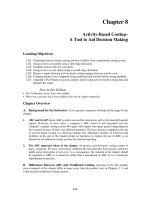Overview managerial accounting chapter 015
Bạn đang xem bản rút gọn của tài liệu. Xem và tải ngay bản đầy đủ của tài liệu tại đây (2.71 MB, 54 trang )
Chapter 15
Service Department Costing—An Activity Approach
Learning Objectives
LO1. Allocate service department costs to other departments using the direct method.
LO2. Allocate service department costs to other departments using the step method.
LO3. Allocate variable and fixed service department costs separately at the beginning of a
period and at the end of the period.
New in this Edition
• New Business Focus boxes have been added.
• The end-of-chapter materials have been expanded to include additional simple exercises..
Chapter Overview
A. Overview of Cost Allocation. Most large organizations have both operating and service
departments.
1.
Operating departments. Operating departments are those departments or units where the
central purposes of the organization are carried out. Ordinarily, the operating departments
are responsible for the major activities that ultimately generate revenue.
2.
Service departments. Service departments provide services or assistance to the operating
departments. Service departments engage in activities that do not generate significant
revenue.
3.
Purpose of service department allocations. Service department costs are allocated to
operating departments for a variety of reasons:
a. To encourage managers of operating departments to make wise use of services
provided by service departments.
b. To provide more complete cost data for making decisions in operating departments.
c. To help measure profitability in the operating departments.
d. To put pressure on the service departments to operate efficiently.
e. To develop overhead rates in the operating departments.
f.
To help determine the cost base in cost-plus pricing.
1026
B. Allocation Bases. Costs of a service department are allocated to other departments using
an allocation base. The allocation base should be whatever activity causes variations in the costs
of the service department; it should drive the service department’s costs. Operating departments
should be charged for whatever costs they cause—no more and no less.
C. Direct and Step Methods of Handling Reciprocal Services. Services provided by
one service department to another are known as interdepartmental or reciprocal services. The
text discusses three approaches to handling the costs of interdepartmental services—the direct
method, the step method, and the reciprocal method.
1.
The Direct Method. (Exercises 15-1 and 15-6.) The direct method ignores
interdepartmental services. Service department costs are directly allocated to operating
departments—bypassing other service departments. This method is slightly easier to use
than the step method, but is less accurate.
2.
The Step Method. (Exercises 15-2 and 15-5.) The step method takes some
interdepartmental services into account, but not all of them.
a. To use the step method, the service departments must be lined up in some sort of order.
The sequence typically begins with the department that provides the greatest amount of
service to other departments and moves down through the service departments to the
one that provides the least amount of service to the other departments. In practice it
isn’t always clear what the order should be, but in all of the illustrations in the text and
in all of the exercise and problem material, the order of allocation is given so that there
is no ambiguity.
b. The procedure followed in the step method is not inherently difficult, but it does
contain some booby traps for unwary students. Starting with the first service
department in the sequence, allocate its costs out to all of the other departments—
including all of the other service departments as well as all of the operating
departments. Ignore the first service department in all subsequent allocations. Now
move on to the second service department in order. Add together its direct costs and all
of the service department costs that have been allocated to it. Allocate these costs out to
all of the remaining service departments (that is, all of the service departments except
for itself and the first service department) and to all of the operating departments.
Continue like this to the bottom of the list of the service departments. When the final
service department is considered, there won’t be any service departments left to
allocate costs to, so its costs (both direct and allocated from other service departments)
will be allocated solely to the operating departments. Working through an example in
class is absolutely essential.
3.
The Reciprocal Method. The direct method ignores interdepartmental services. The step
method attempts to take into account the most important of the interdepartmental service
relationships. The reciprocal method takes into account all of the interdepartmental service
relationships. The reciprocal method doesn’t require any more information than the step
method, but it uses more sophisticated mathematics (matrix algebra) to do the allocations.
Despite the elegance of this approach, it is rarely used. The reasons for the lack of interest
in the reciprocal method are probably a lack of familiarity with the method, a general
perception that it is a difficult and esoteric technique, and the likelihood that in most
1027
situations the results from using the reciprocal method are not a lot different from the
results obtained with the step method.
D. Cost Allocation Guidelines. (Exercises 15-3, 15-4, 15-7, 15-8, and 15-9.) Whenever
possible, fixed and variable service department costs should be allocated separately. This
approach provides more useful data for planning and control of departmental operations as well
as to avoid inequities.
1.
Allocations of variable service department costs. As a general rule, variable costs should
be charged to consuming departments on the basis of whatever activity causes the costs that
are being allocated. Budgeted, or predetermined, rates should be used. There are two
reasons for this. First, it is difficult for departmental managers to decide how much service
to demand if they don’t know the rates until the end of the period. Second, if actual rather
than budgeted rates are used, the consumer of services is implicitly held responsible for
how well the service department controlled its costs.
2.
Allocations at the beginning and end of the period. The measure of activity that should
be used in assigning variable costs depends on whether the allocation is carried out at the
beginning or at the end of the period.
a. If allocations are made at the beginning of the period, variable costs should be allocated
to departments at the budgeted rate based on the budgeted level of activity.
Cost allocated at beginning of the period = Budgeted rate × Budgeted activity
b. If allocations are made at the end of the period, variable costs should be allocated to
departments at the budgeted rate based on the actual level of activity.
Cost allocated at the end of the period = Budgeted rate × Actual activity
3.
Allocations of fixed service department costs. Generally speaking, the fixed costs of
service departments are incurred to provide capacity and the greater the capacity that is
provided, the higher the fixed cost is likely to be. Presumably, before deciding how much
service department capacity to provide, managers are asked how much service they are
going to need. Based on these estimates, the capacity level of the service department is set
and the required fixed costs are incurred. In order to provide some check on how much
service the managers say they are going to require, the operating departments should be
charged for the portion of the capacity they claimed they would require. This should be a
lump-sum charge determined at the beginning of the period.
E. Behavioral Considerations. (Exercise 15-7.) Apart from the sound economics
underlying lump-sum allocations of fixed costs, there is a strong behavioral reason to avoid
allocating fixed costs the same way variable costs are allocated. If fixed costs are allocated to
departments are on the basis of some actual measure of activity such as actual sales or actual
direct labor-hours, then the costs allocated to a given department will depend on what happens in
other departments. The activity in other departments will influence the denominator in the
allocation rate. If activity in other departments falls, the rate will go up and if their activity
increases, the rate will go down. These effects can generate quite a lot of heated (and counterproductive) arguments among managers.
1028
Assignment Materials
Assignment
Exercise 15-1
Exercise 15-2
Exercise 15-3
Exercise 15-4
Exercise 15-5
Exercise 15-6
Exercise 15-7
Exercise 15-8
Exercise 15-9
Problem 15-10
Problem 15-11
Problem 15-12
Problem 15-13
Problem 15-14
Problem 15-15
Problem 15-16
Case 15-17
Case 15-18
Topic
Direct method ........................................................................
Step method...........................................................................
Allocations by cost behavior at the beginning of the period .
Allocations by cost behavior at the end of the period ...........
Step method...........................................................................
Direct method ........................................................................
Sales dollars as an allocation base for fixed costs .................
Allocating variable costs at the end of the year.....................
Allocations of fixed costs ......................................................
Step method versus direct method; predetermined overhead
rates...................................................................................
Allocating by cost behavior...................................................
Allocating costs equitably among divisions ..........................
Step method...........................................................................
Beginning- and end-of-year allocations ................................
Step method; predetermined overhead rates..........................
Step method...........................................................................
Direct method; plant wide versus departmental overhead
rates...................................................................................
Step method versus direct method.........................................
Level of
Difficulty
Basic
Basic
Basic
Basic
Basic
Basic
Basic
Basic
Basic
Suggested
Time
15 min.
15 min.
10 min.
15 min.
20 min.
20 min.
20 min.
15 min.
15 min.
Basic
Basic
Medium
Medium
Medium
Medium
Medium
60 min.
45 min.
30 min.
45 min.
30 min.
60 min.
45 min.
Difficult
Difficult
90 min.
75 min.
Essential Problems: Problem 15-10, Problem 15-11, Problem 15-12, Problem 15-14.
Supplementary Problems: Problem 15-13, Problem 15-15, Problem 15-16, Case 15-17,
Case 15-18.
1029
1
2
1030
Chapter 15
Lecture Notes
Helpful Hint: The McGraw-Hill/Irwin Managerial/Cost
Accounting video library does not contain any segments
related to chapter 15.
1
Chapter theme: Most large organizations have both
operating departments and service departments. The
central purposes of the organization are carried out in the
operating departments. In contrast, service departments do
not directly engage in operating activities. This chapter
discusses why and how service department costs are
allocated to operating departments.
Helpful Hint: Ask students if they ever worked in a
large organization where the charges of service
departments seemed exorbitant. Then ask students why
this happens. Often the reason is that internal work
charges include arbitrary allocations of fixed general
administrative overhead and an allowance for the fixed
costs of the service department itself. This creates a
spiraling effect. Since the charges are so high, demand
falls and the rates are pushed even higher.
I.
Why allocate service department costs?
A. Six reasons for allocating service department costs
2
i.
To encourage operating departments to wisely
use service department resources.
1031
2
3
1032
4
2
II.
ii.
To provide operating departments with more
complete cost data for making decisions.
iii.
To help measure the profitability of
operating departments.
iv.
To create an incentive for service
departments to operate efficiently.
v.
To value inventory for external financial
reporting purposes.
vi.
To include all overhead in the cost base when
cost-plus pricing is used.
Allocations using the direct and step methods
A. Selecting allocation bases
i.
1. When allocating the costs of the employee
cafeteria, the number of meals served
would be a good choice for the allocation
base.
3
ii.
4
The allocation bases used should “drive” the
cost being allocated. For example:
A given service department’s costs may be
allocated using more than one base. For
example:
1. The costs of a human resources department
might be divided into two parts, with one part
allocated based on the number of employees
in each department and the other part
1033
4
5
1034
allocated on the basis of hours spent in training
programs run by the human resources
department.
4
iii.
5
Other examples of allocation bases that are
commonly used by service departments are as
shown.
“In Business Insights”
Activity-based costing can be used to improve the
accuracy of service department allocation. For
example:
“Increasing Accuracy at Hughes Aircraft” (page 719)
• For many years, Hughes Aircraft allocated
service department costs to operating departments
using headcount as the allocation base.
• This method, while simple, was inaccurate
because most service department costs were not
driven by the number of employees in the
operating departments.
• To overcome this problem, the company
implemented activity-based costing. For example,
the costs of the Human Resources Department are
now allocated on the basis of headcount, new
hires, union employees, and training hours in
each operating department.
• Operating managers can control the amount of
Human Resources cost allocated to them by
controlling the quantity of the aforementioned
allocation bases consumed.
1035
6
7
1036
B. Interdepartmental services
i.
1. Services provided between service
departments are known as
interdepartmental or reciprocal services.
2. Three approaches are used to allocate the
costs of service departments to other
departments – these are known as the direct
method, the step method, and the
reciprocal method.
6
ii.
7
Key definitions/terminology
Direct method: a definition
1. The direct method is the simplest of the
three cost allocation methods because it
ignores the services provided by a service
department to other service departments. It
allocates all costs directly to operating
departments.
“In Business Insights”
The direct method of service department allocation is
commonly used in practice. For example:
“A Losing Football Program” (page 720)
• At Georgia Tech, service department costs are
allocated to intercollegiate sports programs using
the direct method.
• For example, the costs of the Sports Medicine
Department are allocated on the basis on the
number of student athletes in each intercollegiate
sport.
1037
8
9
11
1038
10
• Other service departments include Facilities,
Sports Information, Academic Center, StudentAthletes Program, Office Supplies, Legal and
Audit, Accounting Office, Marketing, and
Administrative.
• Georgia Tech’s football program shows a margin
of over $1 million based on its own direct costs,
but a loss of over $800,000 when service
department costs are allocated to the program.
iii.
8
9
10
11
Direct method: an example
1. Assume that a company has two service
departments (Cafeteria and Custodial) and
two operating departments (Machining and
Assembly) with accompanying information
as shown.
2. How much of the Cafeteria and Custodial
costs should be allocated to each
operating department?
3. The Machining Department would be
allocated $144,000 of the Cafeteria
Department’s costs as shown. Notice:
a. The allocation base is the number of
employees.
b. Quantities of the allocation base
attributed to the service departments
are ignored.
4. The Assembly Department would be
allocated $216,000 of the Cafeteria
Department’s costs as shown. Notice:
a. The sum of the costs assigned to
Assembly ($216,000) and Machining
($144,000) is equal to the total costs
1039
11
12
14
1040
13
assigned from the Cafeteria
($360,000).
5. The Machining Department would be
allocated $30,000 of the Custodial
Department’s costs as shown. Notice:
a. The allocation base is square feet
occupied.
6. The Assembly Department would be
allocated $60,000 of the Custodial
Department’s costs as shown. Notice:
a. The sum of the costs assigned to
Assembly ($60,000) and Machining
($30,000) is equal to the total costs
assigned from the Custodial
Department ($90,000).
11
12
13
Helpful Hint: What to include in the allocation base
under the direct method often confuses students. For
example, if personnel department costs are allocated on
headcount, should the Personnel Department
headcount and that of other service departments be
included? While it doesn’t seem to make much sense
economically, the service departments must be excluded
to avoid allocating costs back to the service
departments.
iv.
14
Step method: a definition
1. The step method provides for allocation of a
service department’s costs to other service
departments, as well as to operating
departments. It is sequential and the
sequence usually begins with the department
that provides the greatest amount of
service to other service departments.
1041
14
15
1042
14
15
a. Once a service department’s costs have
been allocated to other departments,
other service department costs are not
allocated back to it.
2. There are three key points to understand
regarding the step method:
a. In both the direct and step methods,
any amount of the allocation base
attributable to the service department
whose cost is being allocated is
always ignored.
b. Any amount of the allocation base that
is attributable to a service department
whose cost has already been
allocated is ignored.
c. Each service department assigns its
own costs to operating departments
plus the costs that have been
allocated to it from other service
departments.
“In Business Insights”
The step method of allocating service department costs
is also commonly used in practice. For example:
“Stepping Down at Group Health” (page 722)
• Group Health Cooperative of Puget Sound is a
large health maintenance organization with 500
service departments that account for 30% of
Group Health’s total costs.
• The step method is used to allocate these costs to
patient care departments and then to patients.
• These allocations are done so that costs can be
summarized in a variety of ways including “by
consumers, by diagnostic groupings, by employer
1043
16
17
18
19
20
21
1044
groups, and by specific populations, such as
Medicare, Medicaid, AIDS, Heart Care, and so
on.”
v.
16
17
18
19
20
21
Step method: an example
1. Assume the same facts that were used for
the direct method example.
2. How much of the Cafeteria and Custodial
costs should be allocated to each
operating department?
a. Assume that the Cafeteria costs are
allocated first followed by the
Custodial Department.
3. The Custodial Department would be
allocated $60,000 of the Cafeteria
Department’s costs as shown. Notice:
a. The allocation base is the number of
employees, and the quantity of
employees in the denominator is 60.
4. The Machining Department would be
allocated $120,000 of the Cafeteria
Department’s costs as shown.
5. The Assembly Department would be
allocated $180,000 of the Cafeteria
Department’s costs as shown. Notice:
a. The sum of the assigned costs
($60,000 + $120,000 + $180,000)
equals the total Cafeteria Department
costs of $360,000.
6. The Custodial Department will allocate
$150,000 in total costs. This amount
includes the department’s own costs of
$90,000 plus the amount allocated from the
Cafeteria Department of $60,000.
1045
22
23
1046
24
7. The Machining Department would be
allocated $50,000 of the Custodial
Department’s costs as shown. Notice:
a. The allocation base is square feet
occupied.
8. The Assembly Department would be
allocated $100,000 of the Custodial
Department’s costs as shown. Notice:
a. The sum of the costs assigned to
Assembly ($100,000) and Machining
($50,000) is equal to the total costs
assigned from the Custodial
Department ($150,000).
22
23
Helpful Hint: What to include in the allocation base
under the step method often confuses students. Never
include in the allocation base the service department
whose cost is being allocated; once a service
department’s cost has been allocated, pretend the
department does not exist anymore. In other words, at
each step allocate a service department’s costs to the
remaining service departments and to all of the
operating departments.
vi.
24
Reciprocal method: a definition
1. The reciprocal method gives full
recognition to interdepartmental services.
While the step method only allocates costs
forward – never backwards – the reciprocal
method allocates costs in both directions.
2. Reciprocal allocation requires the use of
simultaneous linear equations and is
beyond the scope our book.
1047
24
25
1048
24
3. The reciprocal method is rarely used in
practice because of its complexity and
because of the fact that the results usually
are close to those provided by the step
method.
Helpful Hint: Students may object to the inaccuracies of
the step method. This gives an opportunity to explain
the reciprocal method. Ask students what would happen
if every service department’s costs were allocated to all
of the service departments (including itself as
appropriate). Someone should answer that some costs
would still be left in the service departments when the
allocations are finished. Ask what would happen if you
started over and used the same procedure to allocate
the service department costs that remain. Someone
should answer that some costs would still be left in the
service departments, but the costs would be less than
before. In fact, if this process is repeated many times
until no costs are left in the service departments, you
have essentially performed a reciprocal allocation.
25
vii. If a service department generates revenue,
such as a cafeteria that charges for the service
that it provides, the revenue generated should
be offset against the costs incurred. Only the
remaining net amount of costs should be
allocated to other departments.
1049
26
27
28
29
30
31
32
33
1050
